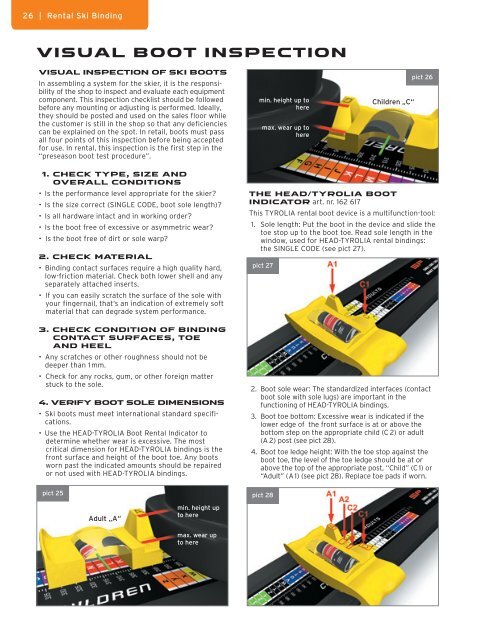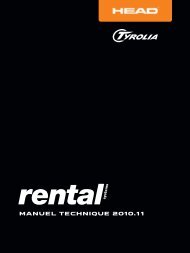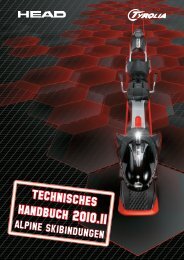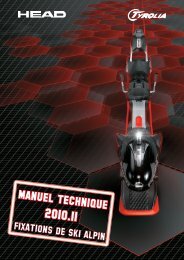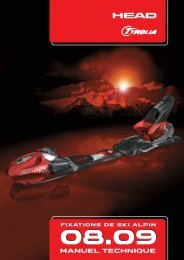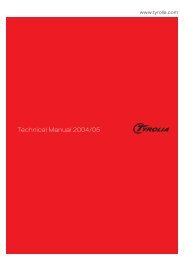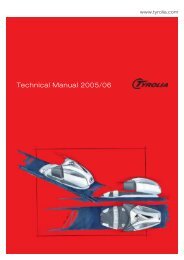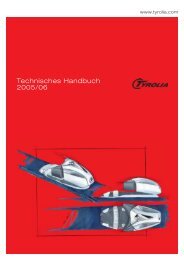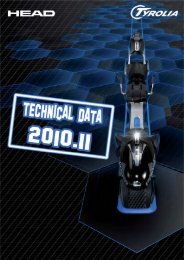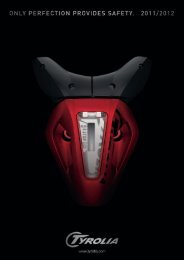Create successful ePaper yourself
Turn your PDF publications into a flip-book with our unique Google optimized e-Paper software.
26 | Rental Ski Binding<br />
visual boot inspection<br />
VISUAL INSPECTION OF SKI BOOTS<br />
In assembling a system for the skier, it is the responsibility<br />
of the shop to inspect and evaluate each equipment<br />
component. This inspection checklist should be followed<br />
before any mounting or adjusting is performed. Ideally,<br />
they should be posted and used on the sales floor while<br />
the customer is still in the shop so that any deficiencies<br />
can be explained on the spot. In retail, boots must pass<br />
all four points of this inspection before being accepted<br />
for use. In rental, this inspection is the first step in the<br />
“preseason boot test procedure”.<br />
1. CHECK TYPE, SIZE AND<br />
OVERALL CONDITIONS<br />
• Is the performance level appropriate for the skier?<br />
• Is the size correct (SINGLE CODE, boot sole length)?<br />
• Is all hardware intact and in working order?<br />
• Is the boot free of excessive or asymmetric wear?<br />
• Is the boot free of dirt or sole warp?<br />
2. CHECK MATERIAL<br />
• Binding contact surfaces require a high quality hard,<br />
low-friction material. Check both lower shell and any<br />
separately attached inserts.<br />
• If you can easily scratch the surface of the sole with<br />
your fingernail, that’s an indication of extremely soft<br />
material that can degrade system performance.<br />
3. CHECK CONDITION OF BINDING<br />
CONTACT SURFACES, TOE<br />
AND HEEL<br />
• Any scratches or other roughness should not be<br />
deeper than 1 mm.<br />
• Check for any rocks, gum, or other foreign matter<br />
stuck to the sole.<br />
4. VERifY BOOT SOLE DIMENSIONS<br />
• Ski boots must meet international standard specifications.<br />
• Use the HEAD-TYROLIA Boot Rental Indicator to<br />
determine whether wear is excessive. The most<br />
critical dimension for HEAD-TYROLIA bindings is the<br />
front surface and height of the boot toe. Any boots<br />
worn past the indicated amounts should be repaired<br />
or not used with HEAD-TYROLIA bindings.<br />
pict 25<br />
Adult „A“<br />
min. height up<br />
to here<br />
max. wear up<br />
to here<br />
min. height up to<br />
here<br />
max. wear up to<br />
here<br />
THE HEAD/TYROLIA BOOT<br />
INDICATOR art. nr. 162 617<br />
This TYROLIA rental boot device is a multifunction-tool:<br />
1. Sole length: Put the boot in the device and slide the<br />
toe stop up to the boot toe. Read sole length in the<br />
window, used for HEAD-TYROLIA rental bindings:<br />
the SINGLE CODE (see pict 27).<br />
pict 27<br />
2. Boot sole wear: The standardized interfaces (contact<br />
boot sole with sole lugs) are important in the<br />
functioning of HEAD-TYROLIA bindings.<br />
3. Boot toe bottom: Excessive wear is indicated if the<br />
lower edge of the front surface is at or above the<br />
bottom step on the appropriate child (C 2) or adult<br />
(A 2) post (see pict 28).<br />
4. Boot toe ledge height: With the toe stop against the<br />
boot toe, the level of the toe ledge should be at or<br />
above the top of the appropriate post, “Child” (C 1) or<br />
“Adult” (A 1) (see pict 28). Replace toe pads if worn.<br />
pict 28<br />
Children „C“<br />
pict 26


